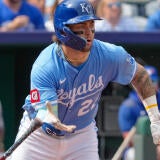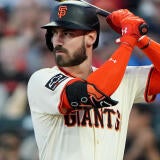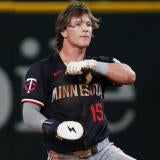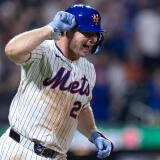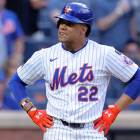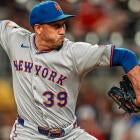Toughest outfielders to rank for 2026: Sure bets like Soto and Acuna are suddenly Fantasy wildcards
High-performing outfielders are tougher to pinpoint than ever before

Some players are tough to project, but they aren't especially tough to rank. Take Juan Soto and Ronald Acuña. I have no idea what to project for either of these guys when it comes to their stolen base totals for 2026, but it doesn't really matter all that much for where I'm going to rank them.
Acuna has been one of the most prolific base stealers in baseball since he debuted back in 2018, leading the majors in steals twice, including a monster 73-steal season in 2023. But since his second torn ACL, he has attempted just nine steals in 90 games this season, and while I do suspect he'll run more often a year further removed from the injury, I have a hard time seeing him being an elite source of steals at this point in his career.
On the other end of the spectrum, you've got Soto, who has 35 of his 92 career steals this season, including 24 in 58 games since the All-Star break. His previous career high was 12, and it's not like he's suddenly a speedster – he's actually by far the slowest player to steal 30 bases in a season in the Statcast era, at least until Josh Naylor hits that milestone this week. Is Soto suddenly an elite base stealer despite declining speed? It's possible, but it's not a bet I want to make.
If I had to set an over/under for both's steals total in 2026, I'd probably go with 19.5 for each, and I genuinely have no idea which way to go on either Acuna or Soto. But here's the thing: It doesn't really matter. That's not to say Soto doesn't greatly benefit from suddenly being a near-elite source of stolen bases – of course, it does! But with 42 homers and 221 combined runs and RBI and counting, he'd be a first-round player in 2026 if he stole five bases. Similarly, Acuna's full-season pace of 34 homers, 128 runs, 70 RBI, 14 steals, and a .285 batting average would make him a first-round caliber player even if he doesn't improve on the steals total.
The steals total will still matter, it will just matter on the margins of their value. Is Soto one of the four best players in Fantasy or one of the 14 best? Can Acuna challenge for the No. 1 spot, or is he more of a late-first-rounder? Those details matter, certainly, but it doesn't necessarily make either all that hard to rank. They're both top-five outfielders for me in 2026.
Let's continue our way-too-early 2026 preview series by looking at the five toughest players to rank in the outfield -- and in case you missed it, here are the toughest players to rank at catcher, first base, second base, third base, and shortstop from the past week:
Sign up for our newsletter to get the latest Fantasy baseball tips to help you win your league.
Pete Crow-Armstrong, Cubs
Because of his defense, Crow-Armstrong might be a better real-life player than a Fantasy player. But he might actually be a much better Fantasy hitter than a real-life hitter, and it's hard to square those two circles simultaneously. When he was locked in during the first half of the season, he was unbelievably good, and it looked like he was coasting to a 30-30 season and a potential first-round ranking. And it wasn't a total mirage – Crow-Armstrong's elite athleticism and good-enough raw power combined with an extremely pull-heavy swing were a killer combo.
But he was always doing it in spite of an absolutely miserable approach at the plate, and that caught up to him in the second half. What's kind of interesting here is that Crow-Armstrong was actually performing better when he was swinging at pitches out of the strike zone more often – his 50-game peak wOBA coincided with a 50-game stretch where he swung at exactly 50% of pitches outside of the strike zone, while he has grown more selective during his second-half slump. Of course, "more selective" for PCA means he is still swinging at nearly 40% of pitches out of the zone, so I don't know if the lesson here really is, "Don't be selective."
I think the lesson might just be that Crow-Armstrong is an inherently streaky player. He might not be that forever, but he sure looks like it right now, and his approach at the plate certainly doesn't help. He's Michael Harris with a swing more geared to putting the ball over the fence and a more aggressive approach at the plate. Which means he's a better version of Harris for Fantasy, but those headache-inducing swings in performance that have defined Harris' career are likely to continue to be an issue for Crow-Armstrong too.
But here's one additional issue that complicates things for Crow-Armstrong: He might not be able to hit lefties. He does have seven of his 29 homers against them, which is nice, but that has come with just an 84.1 mph average exit velocity (up from last season's 81.6 mph average). And he has otherwise looked totally overmatched, with a 29.7% strikeout rate and 2.7% walk rate and .277 xwOBA against them this season. Crow-Armstrong is still young enough to overcome those issues, and his defense should insulate him from much of the playing time risk. But it puts a lot of pressure on him to really perform like a star against righties, and as we're seeing in the second half, that's no guarantee. Part of me thinks we should just take the (near) 30-30 season and poor, but not disqualifying batting average at face value, which would make him a top-30 pick in any Roto league and at least a top-15 outfielder. But I think the downside case here remains compelling enough that I'm a little scared to do it.
Yordan Alvarez, Astros*
*Alvarez is technically going to be DH-only in 2026, but since I'm not doing a DH-only version of this, I wanted to include him here
Usually, when the only case against a player is, "They can't stay healthy," that's a signal to buy that player. Past injuries are predictive of future ones, but only to a certain extent – if predicting injuries were easy, this whole game would be a lot more straightforward. But just because a guy has missed a bunch of time in the past few years does not necessarily mean they will moving forward, and too many Fantasy players (and analysts!) treat injury risk as if it's a binary proposition. When it's actually a range of possible outcomes. But Alvarez probably does have to be viewed on the extreme end of that range … right? He'll certainly be treated that way, with a huge discount likely coming after a season where he will likely play just 48 games in the regular season. Especially since he has never played 150 games in a season and has missed long stretches of pretty much every season so far.
But I just don't know if it's as straightforward as that. Alvarez dealt with serious knee issues early on in his career, but he hasn't gone on the IL with a knee injury since 2023. His issues this season were a fractured hand that was initially misdiagnosed by the Astros training staff – a recurring issue after they similarly seemed to mishandle Kyle Tucker's shin injury the previous season – and then a sprained ankle in September that came about when he slipped while crossing home plate. At least one of those is just rotten luck that doesn't seem likely to be an issue moving forward, and I'd argue neither should really be held against him for 2026.
I'll be in the minority on that one. I know that. And maybe the Alvarez skeptics are right. Fading him for injury risk certainly worked out in 2025, despite him not going on the IL in 2024 – and despite neither of his 2025 injuries being related to the reasons he has been injury prone in the past. I'm open to the idea that, because Alvarez is just a freakishly gigantic human being, he is more susceptible to injuries than your average player. And maybe that explains the past knee issues and his sprained ankle … but does it really make sense to blame the hand injury (the much more serious issue this season) on that?
I'll discount Alvarez, but probably a lot less than most analysts out there. He'll likely end up on the fringe of the second round as one of the few players capable of both hitting 45-plus homers and hitting .300 in the same season. If all goes right for Alvarez, he could put together an Aaron Judge-esque season, and I'll take whatever discount people want to offer.
James Wood, Nationals
I'm starting to think there's an injury here we just haven't found out about. I don't have a good explanation for why Wood has become such a poor baserunner at such a young age. He swiped 14 bases in 79 games last season, but he has just 15 in 152 so far this season. That could be ascribed to changes in coaching and front office philosophy since his rookie season, but the fact that Wood has fallen from 85th percentile in sprint speed to just 61st is what has me wondering if he's been playing hurt. You expect young players to lose some foot speed as they age, especially guys who are 6-foot-7, 234 pounds. But at age 23? That screams "injury" to me.
And that's the biggest concern here, especially since it could also help explain why Wood's strikeout rate has jumped from 28.9% to 32.2%, as well as why he has just generally struggled so much in the second half of the season. After a very promising first half that saw us declare Wood a potential first-round pick at the All-Star break, he has hit just .212/.294/.333 in the second half of the season, with just three homers. Wood did deal with quad tendinitis in Spring Training, but there hasn't been any talk of that being an ongoing issue during the season. Maybe it has been. Frankly, I hope it has been, because the alternative is that maybe Wood's skill set isn't quite as interesting as we thought. He still hits the ball incredibly hard, but with his strikeout rate moving in the wrong direction and his batted ball outcomes still failing to take full advantage of his mammoth raw power, the ability to steal 25-plus bases would serve as a nice bulwark against the risk inherent in his profile. If we can't count on that, Wood becomes a much, much riskier pick for 2026.
Jakob Marsee, Marlins
Last season across two levels of the minors, Marsee hit .200/.345/.315. He wasn't totally hopeless – he walked a ton, had a bit of a pop, and stole 51 bases – but he really didn't look like he would be making a legitimate impact in the majors. But he played his 50th game Tuesday for the Marlins and has been worth nearly 2.5 WAR, hitting .311/.377/.513 with 13 steals and emerging as a legitimately impactful player for Fantasy down the stretch. To say this was unexpected would be just a bit of an understatement.
Which is a good reason to be skeptical about it. Marsee wasn't really a top prospect of much note, and his minor-league production was more "occasionally interesting" than outright impressive.
But he's been exceptionally impressive since getting the call. The surface-level numbers tell that story well enough, but when you dig into the underlying stuff, you come away plenty impressed, too. Especially with the approach. Marsee has been one of the most discerning hitters in the league, chasing after just 19.1% of pitches out of the strike zone, and he pairs that with strong bat control that has led to an 85.3% in-zone contact rate. Don't swing at bad pitches, and make contact with the good pitches you do swing at is a very strong base for a hitter. And he pairs it with enough power to muscle the ball over the right field fence and plenty of line drives.
He isn't likely to keep hitting over .300, and even his .294 xBA seems higher than I'd feel comfortable projecting. But could he hit .280 with 15-plus homers, 35-plus steals, and an excellent on-base percentage that should lead to plenty of runs? That all feels reasonable enough, and that would be baking in plenty of regression. You can make a pretty compelling case Marsee should be a top-100 pick next season, though I won't rank him anywhere near that high. But if I can get him around 150, that feels like a pretty good price to bet on.
To a certain extent, this one is just about the way the game has changed. 15 years ago, a 24-year-old top prospect coming off a .299 average and 43 steals in 105 games as a rookie would be viewed as a cornerstone piece for his team and a potential early-rounder for Fantasy. In 2025, I'm genuinely not sure Simpson is going to be an everyday player for the Rays.
Mostly, that comes down to his defense, which has rated out extremely poorly this season despite his athleticism. But it also comes down to the fact that just hitting .300 and running the bases well isn't enough to guarantee a spot in the everyday lineup anymore. Simpson's .331 OBP is good enough, but it leaves him with very little margin for error if his batting average slips; his .051 ISO makes him one of the most punch-less hitters in the entire league.
That .299 average, along with 70-steal upside, will make Simpson a viable Fantasy option even if he isn't quite an everyday player. But if he hits .270? There's real risk he just outright loses his job, especially if the defense isn't very good. And even at .300, he's been worth just 0.7 WAR per FanGraphs, so there's not necessarily a real need for the Rays to keep him in the lineup if his defense doesn't improve. And, with steals still easier to find than they were even five years ago, paying up for Simpson's steals isn't as much of a priority.
Simpson should be a viable Fantasy option for 2026, but there's a much lower floor here than you might think.
And now here's what you need to know from Tuesday's games around MLB:
Tuesday's standouts
Shohei Ohtani, Dodgers @ARI: 6 IP, 5 H, 0 ER, 0 BB, 8 K
Okay, you've gotta admit, being so beholden to your five-inning plan with Ohtani that you pull him in the middle of a no-hitter, only to let him go six full innings in his literal next start is pretty funny.
I guess as the playoffs loom, the Dodgers are willing to give Ohtani a bit more rope. It helps that he's just been absurdly dominant lately, striking out 27 batters in 19.2 innings over his past four starts, a stretch that has seen him reintroduce his curveball and bring back his full arsenal. Which now goes seven pitches deep. In most fantasy leagues, Ohtani is just going to be drafted as a hitter, but for those where he is a pitcher, he's reminding us this season he can still absolutely be an impact arm. There will be limitations that keep his Fantasy value depressed a bit – he'll be in a six-man rotation and will likely never throw more than 150 or so innings – but he can still be a very impactful pitcher even with those limitations.
Cole Ragans, Royals @LAA: 5 IP, 3 H, 2 ER, 1 BB, 10 K
We mostly just wanted to see Ragans come back from his shoulder injury and look like himself. Mission accomplished. His stuff looks more than fine, and he has 14 strikeouts in 8.2 innings since coming back from the injury. He'll head into the offseason with injury concerns hanging over his head, but the fact that he at least gave us these two starts to feel good about. You can't draft him as a top-15 SP with zero injury concerns, but we know the upside is still there. That's not nothing.
Gavin Williams, Guardians vs. DET: 6 IP, 4 H, 2 ER, 2 BB, 12 K
I've been pretty vocal about my lack of faith in Williams' success this season, but there's one thing I've never doubted, and that's the talent. And, while he hasn't put it on display often enough this season, he sure did Tuesday, relying on his full five-pitch mix for arguably his most dominant start of the season. He had 18 swinging strikes in this one, including seven on the curveball and six on the sweeper, and no surprise, those have been his best pitches all season. Prioritizing those pitches a bit more probably isn't a bad idea, and it's starts like this that make it impossible to ever truly lose faith in Williams. He hasn't done this kind of thing often enough – his expected ERA entering this start was 4.35 – so I'll probably let someone else buy into his 3.06 ERA and apparent breakout, but I'd be lying if I said starts like this don't give me a lot of anxiety about that.
Francisco Alvarez, C, Mets: 1 for 3, 1 HR, 2 RBI, 2 R, 1 BB
I was worried that Alvarez's multiple finger injuries would derail him, but he has continued to hit well since coming back. It's just a .229 batting average in August, but a still solid .781 OPS, and he's up over a .900 OPS since returning from the minors in late July. That demotion seemed to be just what Alvarez needed, as he homered 12 times in 26 games at Triple-A and now has seven in 37 games since returning. That won't be enough for Alvarez to play his way into the top-12 catcher discussion for 2026, but he's going to be a high-priority No. 2 catcher target for me in all leagues where you start more than one. Remember: He's still 23 and was one of the most hyped catcher prospects in recent years, so it wouldn't be that big of a surprise if he was finally breaking out.
Michael Harris, OF, Braves: 2 for 3, 2 HR, 2 RBI, 2 R
I almost included Harris in my "toughest players to rank" section up above, but the truth is, I don't actually know what I'm going to do with him, either. He has a similar skill set as Pete Crow-Armstrong, just a bit less loud – he'll finish around 10 homers and 10 steals behind him. But he might have a stronger overall skill set as a hitter and has more batting average upside as a result. Could Harris hit .280 while going 25-25? I still think the ceiling looks something like that, and let's not forget that he won't even turn 25 until just before next year's Opening Day. I know a lot of you have soured on Harris, but I'm not giving up on him.
Edward Cabrera, Marlins @PHI: 4 IP, 5 H, 3 ER, 1 BB, 3 K
This was Cabrera's first start since suffering an elbow sprain, and this is a spot where you mostly just want to see him get out of the start healthy while looking like himself. He accomplished that, and based on the growth Cabrera showed this season, I think he should probably be drafted as a top-50 SP with upside for 2026. n
Hurston Waldrep, Braves vs. WAS: 6 IP, 5 H, 1 ER, 4 BB, 5 K
I don't know what to do with Waldrep. I think there's a decent chance his command has wavered lately because he is approaching 50 more innings than he threw last season. I buy that explanation. But it's not like we have a long track record of him pitching well even in the minors – he had a 4.42 ERA at Triple-A before his promotion, with a pretty ugly 4.9 BB/9. Waldrep has that splitter, a legitimately elite pitch, and his expanded arsenal has mostly worked for him since his promotion. But there's a lot of ways things could go wrong for him, and I'm probably just throwing him in that same range as Cabrera for 2026.
Lucas Giolito, Red Sox @TOR: 4.2 IP, 3 H, 1 ER, 4 BB, 3 K
If this is it for Giolito until the playoffs, he'll finish with a 3.41 ERA in 145 innings of work, a pretty excellent bounce back, and his finest season since 2021. I also have very little interest in drafting him for 2025. He showed much less strikeout upside than he did prior to his elbow injury, and that never really got better – he had just an 18.3% strikeout rate in the second half. Most of his ERA estimators suggested Giolito deserved a mark starting with a four, and given the lack of apparent strikeout upside, I just don't see much reason in betting on him as anything more than a late-round flier.
David Peterson, Mets @CHC: 1.1 IP, 5 H, 5 ER, 2 BB, 1 K
Peterson spent about a year and a half outpitching his peripherals, and still had an ERA below 3.00 as recently as the end of July. So, the case for him was, sure, you get mediocre strikeout numbers and a bad WHIP, but he had that ability to keep runs off the board that still made him valuable. But he's completely fallen apart over the past two months, and his ERA is now up to 4.22, blowing a hole in the only real argument for him in Roto. I think he's probably more like a 4.00 ERA pitcher, and with his WHIP problems and middling strikeout upside, I just don't think Peterson is someone who needs to be drafted in most leagues in 2026. And that's assuming he is guaranteed a rotation spot for the Mets, which is no certainty.
Zebby Matthews, Twins @TEX: 7 IP, 4 H, 1 ER, 0 BB, 6 K
Matthews is definitely going to be on my sleepers list for 2026. It was a pretty bad season for him, but it's not like there wasn't anything to get excited about. He's going to end up with a strikeout rate around 25% and a walk rate around 7%, with a K-BB% of 18.1% that would be just ahead of Kevin Gausman for the 17th-best mark if he qualified. Matthews' inability to limit hard contact undid whatever good that did, but quality of contact for pitchers tends to fluctuate a lot more than strikeouts and walks, and if he finds a way to limit damage a bit better in 2026, there could still be some upside here. I'll be making some reserve round bets that he finds it in.

